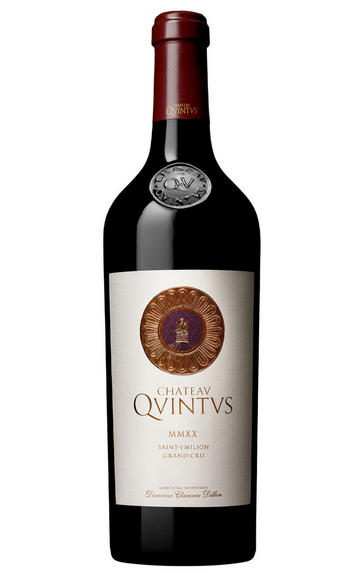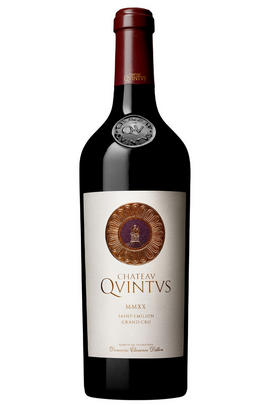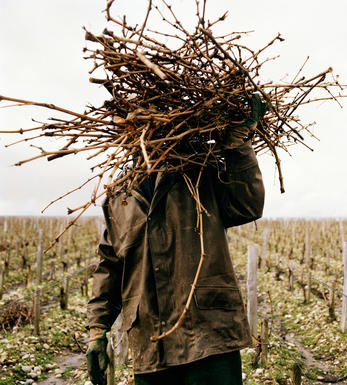
2022 Château Quintus, St Emilion, Bordeaux

Critics reviews
The 2022 Quintus represents the first vintage with the full 42 hectares in production after the acquisition of Château Grand Pontet. It contains the highest percentage of Cabernet Franc at 41.5% of the blend. Matured in 39% new oak, it has an opulent but delineated and fresh bouquet, very focused and pure black cherries, hints of cassis and light iris flower aromas.
The palate is medium-bodied with fine-boned tannins, layered dark berry fruit laced with black tea and black pepper. Nicely structured on the finish. The Cabernet component lends a subtle savoury touch. It will need several years in bottle, but this classy Saint-Émilion should age well over two or three decades.
Drink 2032 - 2052
Neal Martin, Vinous.com (April 2023)
Rich and luscious in feel, with intense bright berry fruits set against fennel, anis, and bitter black chocolate. The alcohol brings some heat to the finish, which is fully charged; the slate, chalky edge to the tannins is welcoming, and there is clear complexity here. 38% new oak. No outside consultant.
3.7ph, 38% of production in the first wine. 42ha in production since the addition of Grand Pontet in 2021. Audrey Bernard joined the technical team in March 2021, direct from Opus One, plus new director Mariette Veyssiere.
Drink 2029 - 2040
Jane Anson, JaneAnson.com (May 2023)
The 2022 Quintus, one of the best wines produced at this estate, reveals the aromas of dark berries, liquorice, ripe plum, spices, and hints of graphite. It’s fleshy, concentrated, precise, and crystalline, with a tensile, chalky profile, velvety tannins, and a vibrant, penetratingly saline finish.
The integration of fruit from Grand Pontet, recently acquired by the Dillon group, means that the blend now contains fully 41.5% Cabernet Franc, bringing more mid-palate structure and amplifying Quintus’s limestone-influenced character.
Yohan Castaing, Wine Advocate (April 2023)
58.5% Merlot, 41.5% Cabernet Franc. Includes parcels from Ch Grand-Pontet for the first time this year. 28% of the total production. Cask sample.
Built for the long term, so it will need time. Deep crimson hue. Subtle red-fruit aroma. Opulent and mouth-filling on the palate but fresh. Firm tannic frame behind. Powerful and long, a chalky-saline note on the finish is a reminder of the limestone-clay terroir.
Drink 2030 - 2045
James Lawther MW, JancisRobinson.com (May 2023)
Black berry and lead pencil on the nose with fresh flowers. Some rose stems, too. Full-bodied with racy and fine tannins that run the length of the wine. Complex and intense in flavour, it remains full of energy and verve. 58.5% merlot and 41.5% cabernet franc.
James Suckling, JamesSuckling.com (April 2023)
Rich, bold and muscular, supple and generous. Sleek with well-defined edges to the ripe blackcurrant and cherry fruit - lively and bright, with balanced acidity with some salty minerality. You can feel the concentration in the depth and intensity of the fruit, but this has definition and such purity.
Really well worked, on the strong side, you feel a bit more of the hot vintage here in the slightly narrow finish and spice throughout. Lovely mouth-filling texture with lots of complexity, nuance and strength. This will have fans. 3.7pH.
Drink 2028 - 2040
Georgina Hindle, Decanter.com (April 2023)
About this WINE

Chateau Quintus
The Clarence Dillon family company acquired a beautiful estate in Saint-Emilion, and renamed it Château Quintus. An exceptional terroir that has been recognised as such for centuries. The estate naturally wraps around a high promontory which represents the end of the plateau of Saint-Emilion. The vineyard benefits from a majestic panarama extending towards the neighbouring village and across the entire Dordogne valley. It is in the place that, for time immemorial, a watch tower has stood to ensure the defence of the village of Saint-Emilion.
The originality of this extraordinary terroir lies in its diversity of soils, slopes and orientations. It is therefore hardly surprising that this wine was featured between 1844 and 1848 - under its old name Château Tertre Daugay - among the 14 most sought after and most expensive wines of Saint-Emilion. For close to a century the great reference book Cocks and Feret "Bordeaux et ses Vins" will consistently mention the property as a First Growth of Saint -Emilion. The vineyard was also one of the prominent Saint-Emilion estates to receive a gold medal at the Exposition Universelle de Paris in 1867.
A text found in another great book of the time "Les Grands Vins de Gironde" de Dumas et Lallemand (1899) reads "One can not imagine a more beautiful situation for an estate, or one more favourable for the production of a First Growth wine (...) Thanks to the excellent vinification practices undertaken at the estate, the wine produced here reflects great body, ripeness and an armature that exemplify the great wines of Saint-Emilion."
This wine takes its natural place alongside the red and white wines of Château Haut-Brion and Château La Mission Haut-Brion, thereby becoming the 5th child in this illustrious family.

St Émilion
St Émilion is one of Bordeaux's largest producing appellations, producing more wine than Listrac, Moulis, St Estèphe, Pauillac, St Julien and Margaux put together. St Emilion has been producing wine for longer than the Médoc but its lack of accessibility to Bordeaux's port and market-restricted exports to mainland Europe meant the region initially did not enjoy the commercial success that funded the great châteaux of the Left Bank.
St Émilion itself is the prettiest of Bordeaux's wine towns, perched on top of the steep limestone slopes upon which many of the region's finest vineyards are situated. However, more than half of the appellation's vineyards lie on the plain between the town and the Dordogne River on sandy, alluvial soils with a sprinkling of gravel.
Further diversity is added by a small, complex gravel bed to the north-east of the region on the border with Pomerol. Atypically for St Émilion, this allows Cabernet Franc and, to a lesser extent, Cabernet Sauvignon to prosper and defines the personality of the great wines such as Ch. Cheval Blanc.
In the early 1990s there was an explosion of experimentation and evolution, leading to the rise of the garagistes, producers of deeply-concentrated wines made in very small quantities and offered at high prices. The appellation is also surrounded by four satellite appellations, Montagne, Lussac, Puisseguin and St. Georges, which enjoy a family similarity but not the complexity of the best wines.
St Émilion was first officially classified in 1954, and is the most meritocratic classification system in Bordeaux, as it is regularly amended. The most recent revision of the classification was in 2012

Merlot/Cabernet Franc
Merlot and Cabernet Franc are grape varieties commonly used in Bordeaux-style blends, particularly in the Bordeaux region of France. When these two grapes are blended, they can create a wine that combines the best characteristics of each variety.
Merlot is known for its smoothness, soft tannins, and ripe fruit flavours. It often contributes black cherry, plum, and chocolate flavours to the blend. The grapes are relatively easy to grow and ripen earlier than other Bordeaux varieties, making them versatile for blending.
Cabernet Franc, on the other hand, adds structure, depth, and complexity to the blend. It typically brings aromas of red fruits such as raspberry and strawberry, along with herbal notes like bell pepper and tobacco. These grapes have thinner skins and can be more challenging to cultivate, requiring specific growing conditions to reach their full potential.
When Merlot and Cabernet Franc are combined, the result is a well-balanced wine with various flavours and aromas. The blend often exhibits a Bordeaux wine's medium to full body, along with a smooth texture and moderate tannins. The specific flavour profile can vary depending on the proportions of each grape in the blend and the terroir and winemaking techniques employed.


Buying options
Add to wishlist
Description
Created in 2011, Ch. Quintus is owned by Ch. Haut-Brion. Its footprint was increased in 2020 with the acquisition of Ch. Grand-Pontet; Quintus now has 42 hectares in production. The additional parcels push up the proportion of Cabernet Franc to a new high (42%) for the blend.
The bouquet is appealing, lifted and perfumed, with a note of raspberry fruit pastille. The palate has a lot of tension – the contribution of the new parcels planted on limestone near Ch. Beau-Séjour Bécot. This feels like a step up: more complexity, grip, and minerality.
Merlot 58%; Cabernet Franc 42%
Drink 2028 - 2040
Score: 16/20
Berry Bros. & Rudd (April 2023)
wine at a glance
Delivery and quality guarantee